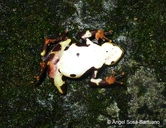|
Atelopus glyphus Dunn, 1931
Pirri Harlequin Frog | family: Bufonidae genus: Atelopus |
 © 2019 Ángel Sosa-Bartuano (1 of 14) |
|
|
|
Description Distribution and Habitat Country distribution from AmphibiaWeb's database: Colombia, Panama
Life History, Abundance, Activity, and Special Behaviors Trends and Threats Habitat loss may also be an issue; it is not known whether this species can survive in disturbed forest. Atelopus glyphus occurs in two protected areas, one in Panama (Parque Nacional Darién, a World Heritage Site) and one in Colombia (Parque Nacional Natural los Katíos) (Ibañez et al. 2004). Although this ensures that some suitable habitat is present, it does not in any way ensure protection from chytrid fungus, which has decimated many species in pristine areas (La Marca et al. 2005). Relation to Humans The goal is to raise $53,000 by June 2, 2009, for a species-specific rescue facility and costs associated with the first year of operation. The "amphibian pod" rescue facility will be based at the Summit Zoo in Panama City, Panama. It will begin with about 20 wild-caught breeding pairs, eventually reaching up to 500 frogs including captive-bred offspring. Initial breeding efforts at the El Valle del Anton Amphibian Conservation Center in Panama were successful, indicating this species is a good candidate for captive management until wild populations can be re-established. The rescue facility itself consists of a 40' shipping container, modified to include shelves, tanks, plumbing, an electrical system, HVAC (heating, ventilation and air conditioning), a water heater, and a repressurization pump and water storage container, as well as a large window for public viewing. The container itself, plus modification, plus shipping to Panama and hooking up to utility lines, costs a total of approximately $41,000. The first year of operating costs will be $12,000. The concept of using a modified shipping container as an "amphibian pod" rescue facility was pioneered in Australia. The Summit Zoo hopes eventually to use a number of these "amphibian pods" to house more colonies of endangered amphibians from the central region of Panama, where chytrid has had a severe impact. Possible reasons for amphibian decline General habitat alteration and loss Comments Chytridiomycosis is thought to be a primary factor in the decline and disappearance of species in this genus (La Marca et al. 2005). Most Atelopus species are restricted to very limited areas (no more than two localities) and occur along mid- to high-elevation streams at 1500-3000 m asl (Lötters 2007). This habitat preference is frequently associated with the co-occurrence of chytridiomycosis (La Marca et al. 2005). Although habitat loss has occurred within the ranges of many Atelopus species, it does not appear to be a major factor in the declines of most Atelopus species; 22 species declined despite occurring in protected areas (La Marca et al. 2005). Many Atelopus species are local endemics, putting them at particular risk of extinction, with at least 26 species known only from a single population inhabiting a narrow altitudinal range (La Marca et al. 2005). Due to their restricted ranges, they are also thought to have limited ability to adapt to warming climatic conditions (Lötters 2007). Atelopus glyphus was first described by Dunn (1931), as Atelopus varius glyphus.
References
Dunn, E. R. (1931). ''New frogs from Panama and Costa Rica.'' Occasional Papers of the Boston Society of Natural History, 5, 385-401. Ibáñez, R., Solís, F., Jaramillo, C., Fuenmayor, Q., Lötters, S, Rueda, J. V., and Acosta-Galvis, A. (2004). Atelopus glyphus. In: IUCN 2008. 2008 IUCN Red List of Threatened Species. www.iucnredlist.org. Downloaded on 09 March 2009. La Marca, E., Lötters, S., Puschendorf, R., Ibáñez, R., Rueda-Almonacid, J. V., Schulte, R., Marty, C., Castro, F., Manzanilla-Puppo, J., García-Pérez, J. E., Bolaños, F., Chaves, G., Pounds, J. A., Toral, E., and Young, B. E. (2005). ''Catastrophic population declines and extinctions in neotropical harlequin frogs (Bufonidae: Atelopus).'' Biotropica, 37(2), 190-201. Lötters, S. (2007). ''The fate of the Harlequin Toads — help through a synchronous multi-disciplinary approach and the IUCN ‘Amphibian Conservation Action Plan’.'' Zoosystematics and Evolution, 83( Supplement 1), 69-73. Savage, J.M. (1972). ''The harlequin frogs, genus Atelopus, of Costa Rica and western Panama.'' Herpetologica, 28(2), 77-94. Starrett, P. (1967). ''Observations on the life history of frogs of the family Atelopodidae.'' Herpetologica, 23(3), 195-204. Originally submitted by: Kellie Whittaker (first posted 2009-03-04) Edited by: Kellie Whittaker (2009-03-09) Species Account Citation: AmphibiaWeb 2009 Atelopus glyphus: Pirri Harlequin Frog <https://amphibiaweb.org/species/53> University of California, Berkeley, CA, USA. Accessed Nov 22, 2024.
Feedback or comments about this page.
Citation: AmphibiaWeb. 2024. <https://amphibiaweb.org> University of California, Berkeley, CA, USA. Accessed 22 Nov 2024. AmphibiaWeb's policy on data use. |



 Map of Life
Map of Life